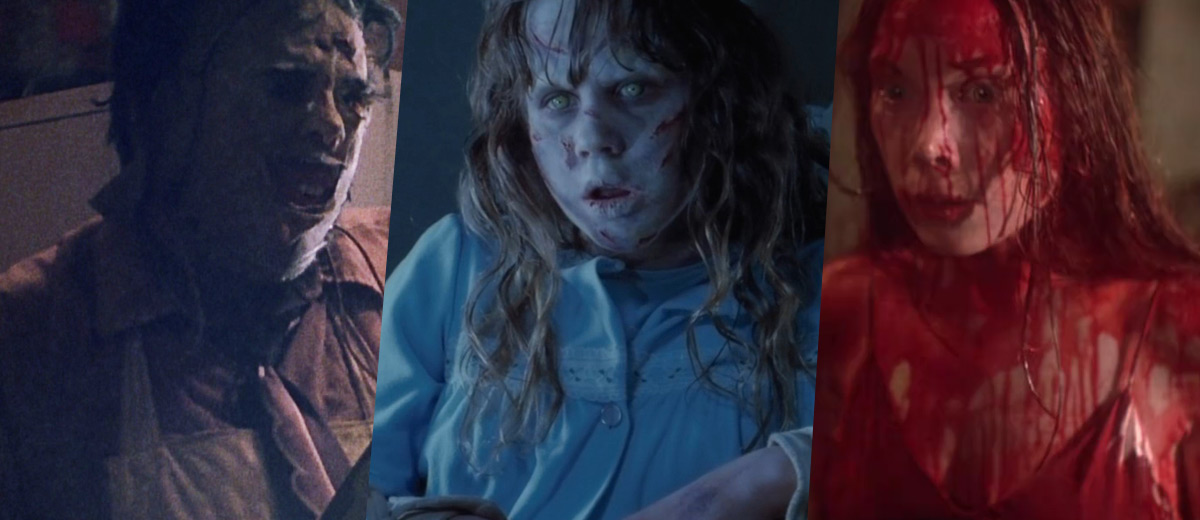
20. “Deep Red” (1975)
Argento stepped away from giallo for 1973’s rightfully forgotten period comedy “The Five Days,” but came roaring back with “Deep Red,” an appropriately-named horror that might mark the Platonic ideal of the giallo aesthetic, with its setting in overwhelming architecture, first-person camera movements, unreliable perspectives, over-saturated colors and lingering close-ups of stray objects. OK, there’s a story about an American pianist (David Hemmings) who witnesses a gruesome murder in his own apartment building, and spends the entire film in a staple-giallo pursuit of perception, chasing that one detail he can’t quite remember or put into context. But the film’s really about visions and textures, featuring characters dwarfed by columns and statues virtually buried in concrete. It’s regressive and not as scary as the masterpiece that would follow a few years later, but boy is it utterly, almost palpably gorgeous.
 19. “Black Christmas” (1974)
19. “Black Christmas” (1974)
John Carpenter’s “Halloween” (see below) gets most of the credit for starting the slasher movie craze that persists to this day, but a few years beforehand, Canadian horror “Black Christmas” arguably beat it to the punch (though giallo and Hitchcock’s “Psycho” were prototypes in some ways). Directed by Bob Clark, the film sees a group of sorority sisters (including Olivia Hussey, Margot Kidder and Andrea Martin) stalked in the run up to the holidays by nuisance caller who is picking them out one by one. It might seem a bit bit basic to desensitized slasher fans, but the film still has a strong power today, in large part because it’s so reluctant to comfort the audience. Whereas many horrors come down to good vs. evil, the terror here is particularly unnerving because it’s so unexplained and unmotivated, with Clark even going so far as to deliver a particularly bleak conclusion along with some clear-eyed, unsparing suspense.

18. ”Who Can Kill a Child?” (1976)
Unless you’re a horror aficionado, you may have missed Narciso Ibáñez Serrador’s newly-minted cult classic, the Spanish-language “Who Can Kill a Child?”—the film was only recently rediscovered after decades of obscurity. But discovery way after the fact is its own sort of pleasure, especially as this effectively unsettling b-movie does gain some of its subversive thrill from a kind of time capsule vibe. Mostly, it’s just plain creepy, with an almost mondo vibe to its no-star, low-budget, on-location shooting. It’s the story of a vacationing biologist and his pregnant wife who discover that the children of this tiny Mediterranean island have slaughtered the adults. But it’s more than just a variation on “Children of the Corn”: an extended prologue of desperately upsetting documentary footage of humanitarian disasters that have claimed millions of children’s lives provides grim social context and a chilling suggestion that these kids might be justified in their pathological distrust of the adult world.
 17. “Martin” (1978)
17. “Martin” (1978)
George Romero’s obviously best known for his pioneering ‘Dead’ series of zombie films, but Romero’s own favorite of his oeuvre came the one time he abandoned zombies for the vampire milieu. But it’s not quite that simple… “Martin” centers on John Amplas’ title character, a young man who claims to be a vampire. Romero never includes any supernatural elements, and keeps it deliberately ambiguous as to whether that’s the case or whether Martin is simply psychotic. The result is the most grounded genre film he ever made, and it might be his most terrifying as a result: the psychology of the character, complete with a troubled relationship to sexuality and a powerful ego, seems drawn more from real-life serial killers than from Bram Stoker’s Count et al. And yet Martin is curiously sympathetic too: Amplas’ finely tuned performance embodies a certain kind of adolescent desperation even as he’s draining blood from his victims.
 16. ”The Brood” (1979)
16. ”The Brood” (1979)
A standout of queasy horror in Cronenberg’s never-knowingly-not-queasy oeuvre, “The Brood” is also the film that kicked off an unparalleled run during which the great Canadian director made five or six classics on the trot into the 1980s. While critical appraisal was mixed at the time, “The Brood” has recently been sealed with Criterion approval, as befits its comprehensive rehabilitation as terrifically nasty horror film. Featuring the trademark paradox of Cronenberg’s approach (his films are deeply concerned with bodies, disease, mutilation and mutation while also being clinically cerebral), it is also one of his most personal. The story of a woman’s (Samantha Eggers) not at all sublimated rage at her childhood abuse manifesting, via the ministrations of a sinister doctor (Oliver Reed), in malevolent parthenogenetic offspring that do her subconscious bidding, the film was made during a protracted, bitter custody battle after Cronenberg’s divorce, and the pain, fear and viciousness of that state of mind are unmistakable.






Martin, The Shout and The Omen are way too low.
‘The Omen’ should be Top 5.
Uh… no
No Dawn of the Dead? That’s one pretty glaring omission I noticed right off the bat. Lots of great stuff here, both in the list itself and in some of the honorable mentions (Abominable Dr. Phibes and Phantom of the Paradise FTW)!
Maybe re-read through the list? Keep an eye out for #7…
Being a long time Movie buff, it’s hard to fathom, but only watched “The Exorcist” for the 1st time maybe a year or so ago. What a great & memorable film. Don’t know what it is, but it really sticks with you.
When it originally came out, was at a very tough place in life. Out on the road for the 1st time with a Rock & Roll band & the associated Wild Times that entailed. Was not in a place where I needed to see such a movie so didn’t. And then somehow proceeded to forget about it all these long years.
Hitchcock’s “Frenzy”.
The Exorcist!
No “The Sentinel” ???
Alice Sweet Alice!
i cant believe you guys put dont look now and the exorcist higher than suspiria